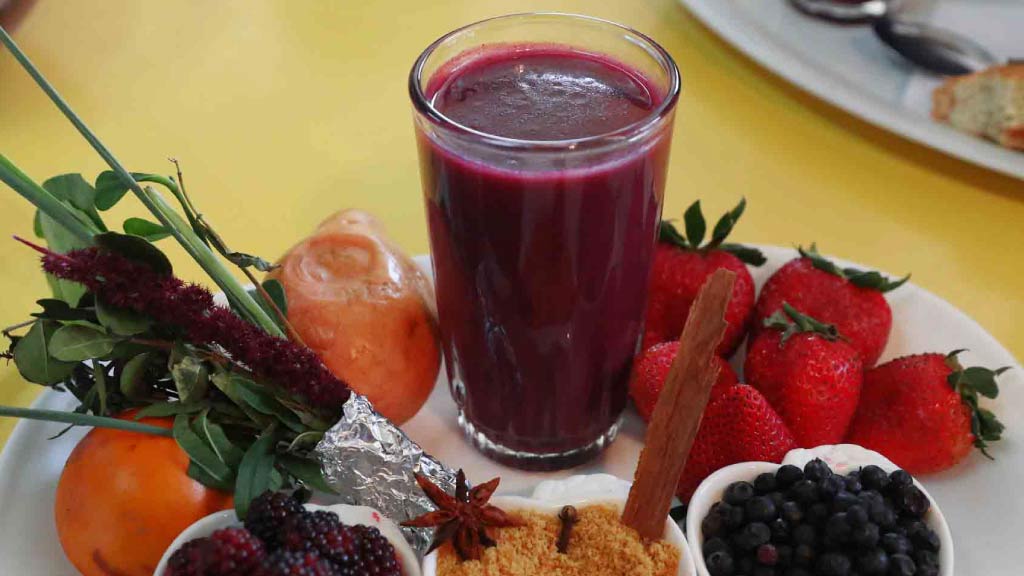With an abundance of mouthwatering exotic fruits, Ecuador has many delicious (and cheap) fruit juices, or jugos. Popular fruits native to Ecuador include naranjilla, a tangy, orange-colored fruit; tomate de Arbol, a fruity tree-grown tomato with a kick; mora (blackberry); guanabana (soursop), an almost milky, sweet, white fruit; and tangy maracuya (passion fruit). Papaya, pineapple, and mango juices are also widely available. Juices can be ordered with leche (milk) or agua pura (water); when ordering with water, be sure to order it sin hielo (without ice) just in case the ice is made with tap water.
Ecuadorian Beverages
 Ecuadorian families normally have fresh jugo with breakfast every day. Most restaurants offer a variety of juices as well; be sure to ask for what’s fresh. Jugo naturales are straight-up fruit juice, while batidos are fruit smoothies mixed with yogurt and/or milk. Drinkable yogurt, available in many fruit flavors, is also very popular.
Ecuadorian families normally have fresh jugo with breakfast every day. Most restaurants offer a variety of juices as well; be sure to ask for what’s fresh. Jugo naturales are straight-up fruit juice, while batidos are fruit smoothies mixed with yogurt and/or milk. Drinkable yogurt, available in many fruit flavors, is also very popular.
Chicha de is a spiced pineapple drink made by simmering the pineapple skins and core with hard brown sugar and spices. Colada de avena is a typical drink from Ecuador made with oats, naranjilla fruit, panela or brown sugar, water and cinnamon.
Colada morada is a traditional Ecuadorian beverage prepared with purple or black corn flour and fruits such as naranjilla, babaco, pineapple, mora, strawberries, and blueberries. The drink is sweetened with cane sugar, known as panela, and prepared with spices such as cinnamon, allspice, cloves and herbs such as lemongrass and lemon verbena. It is traditionally consumed on November 2 — Día de Difuntos — with guaguas de pan, which are sweet bread figures shaped like babies and often decorated with colorful icing and filled with fruit jam.
Coffee, Tea and Soda
Bottled and canned carbonated drinks (including Coca Cola, Sprite and Fanta) are widely available throughout the country. The Peruvian sodas Kola Real (KR) and Big Cola are also bottled in Ecuador.
Ecuador produces excellent coffee, but surprisingly, most Ecuadorians seem to prefer instant to brewed coffee. This could be because most of the best coffee beans are shipped abroad. Café pasado is a super-concentrated coffee brew served in a small cruet; add this to the cup of hot water or milk you are served. You can usually find a well-brewed cappuccino in the bigger cities and most tourist haunts.
As the name suggests, Horchata lojana is a tea type drink from the Loja province. It is made from a variety of herbs and flowers including escancel or bloodleaf, lemon verbena, lemon grass, mint, chamomile, lemon balm, rose geranium, among others. Regular and herbal teas are also popular; most restaurants serve tea of some sort.
Andean Specialty Drinks
Morocho, also called morocho dulce or morocho de leche, is a thick sweet drink made with morocho corn, milk, cinnamon, sugar and raisins. Morocho is a classic Andean comfort drink and is primarily sold on the streets or at markets. The consistency is similar to a pudding milkshake and can usually be eaten with a spoon.
Canelazo (or canelito), a fiesta drink similar to a hot toddy made of boiled water, aguardiente, lemon or orange, sugar and cinnamon, is very popular throughout the Andes. Aguardiente (a sugar cane-based spirit) is probably the most popular national alcohol; the name literally means “fire water” in Spanish as the spirit is 60-100 proof.
Chicha is a traditional concoction found throughout the Andes, made from fermented corn, rice or yucca. In some rural parts of Ecuador the fermentation process is augmented by human saliva. Chicha-makers (traditionally women) chew the ingredients before putting them back in the pot to brew!